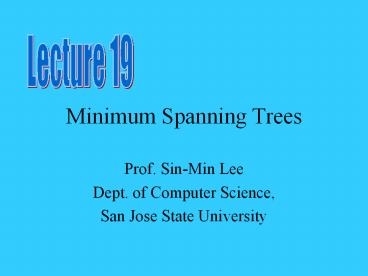Minimum Spanning Trees PowerPoint PPT Presentation
1 / 45
Title: Minimum Spanning Trees
1
Minimum Spanning Trees
Lecture 19
- Prof. Sin-Min Lee
- Dept. of Computer Science,
- San Jose State University
2
In the design of electronic circuitry, it is
often necessary to make the pins of several
components electrically equivalent by wiring them
together. To interconnect a set of n pins, we can
use an arrangement of n 1 wires, each
connecting two pins. Of all such arrangements,
the one that uses the least amount of wire is
usually the most desirable. We can model this
wiring problem with a connected, undirected graph
G (V,E), where V is the set of pins, E is the
set of possible interconnections between pairs of
pins, and for each edge (u, v) ? E, we have a
weight w(u,v) specifying the cost (amount of wire
needed) to connect u and v.
3
We then wish to find an acyclic subset T ? E that
connects all of the vertices and whose total
weight is minimized. Since T is acyclic and
connects all of the vertices, it must form a
tree, which we call a spanning tree since it
spans the graph G. We call the problem of
determining the tree T the minimum-spanning-tree
problem.
4
(No Transcript)
5
Undirected graph and 3 of its spanning trees
Spanning Trees
Undirected Graph
6
Spanning trees
- Suppose you have a connected undirected graph
- Connected every node is reachable from every
other node - Undirected edges do not have an associated
direction - ...then a spanning tree of the graph is a
connected subgraph in which there are no cycles
7
Finding a spanning tree
- To find a spanning tree of a graph,
- pick a node and call it part of the spanning tree
- do a search from the initial node
- each time you find a node that is not in the
spanning tree, add to the spanning tree both the
new node and the edge you followed to get to it
8
Minimizing costs
- Suppose you want to supply a set of houses (say,
in a new subdivision) with - electric power
- water
- sewage lines
- telephone lines
- To keep costs down, you could connect these
houses with a spanning tree (of, for example,
power lines) - However, the houses are not all equal distances
apart - To reduce costs even further, you could connect
the houses with a minimum-cost spanning tree
9
Minimum-cost spanning trees
- Suppose you have a connected undirected graph
with a weight (or cost) associated with each edge - The cost of a spanning tree would be the sum of
the costs of its edges - A minimum-cost spanning tree is that spanning
tree that has the lowest cost
10
(No Transcript)
11
(No Transcript)
12
(No Transcript)
13
(No Transcript)
14
(No Transcript)
15
(No Transcript)
16
(No Transcript)
17
(No Transcript)
18
(No Transcript)
19
(No Transcript)
20
(No Transcript)
21
(No Transcript)
22
Applications of Spanning Trees
- Minimal path routing in all kinds of settings
- circuits, networks, roads and sewers
23
Prims algorithm
1
28
1
2
10
2
10
14
16
7
3
6
7
3
6
24
25
12
18
5
5
22
4
4
24
Prims algorithm
1
28
1
2
10
2
10
14
16
7
3
6
7
3
6
24
25
25
12
18
5
5
22
4
4
25
Prims algorithm
1
28
1
1
2
10
2
10
14
16
7
3
6
7
3
6
24
25
25
12
18
5
5
22
22
4
4
26
Prims algorithm
1
28
1
2
10
2
10
14
16
7
3
6
7
3
6
24
25
25
12
18
5
12
5
22
22
4
4
27
Prims algorithm
1
28
1
2
10
2
10
14
16
16
7
3
6
7
3
6
24
25
25
12
18
5
12
5
22
22
4
4
28
Prims algorithm
1
28
1
2
10
2
10
14
16
16
14
7
3
6
7
3
6
24
25
25
12
18
5
12
5
22
22
4
4
Cost 99
29
Kruskals algorithm
- Pick the cheapest edge that does not create a
cycle in the tree - Add the edge to the solution and remove it from
the graph. - Continue until all nodes are part of the tree.
30
Spanning Tree
How do we plow the fewest roads so there
will always be cleared roads connecting any two
towns?
31
Spanning Tree
Old Town
Etna
Orono
Herman
Bangor
Hampden
32
Kruskals Algorithm
- Start by initializing a graph K with all of Gs
nodes and none of Gs edges. - For each edge (x,y) in G (taken in increasing
order of weight) - If x and y are not in same connected component
- Add edge (x,y) to K
33
Kruskals Algorithm
34
Kruskals Algorithm
35
Kruskals Algorithm
36
Kruskals Algorithm
37
Kruskals Algorithm
38
Kruskals Algorithm
E,D already connected
39
Kruskals Algorithm
5
E
2
A
D
K
1
5
B
8
C
F
40
Kruskals Algorithm
B,D already connected
41
Kruskals Algorithm
C,D already connected
42
Compare Prim and Kruskal
- Which one is better?
- Which one would you use if
- you dont know the entire graph at the beginning?
- you always want a tree in partial solutions?
43
(No Transcript)
44
(No Transcript)
45
(No Transcript)

